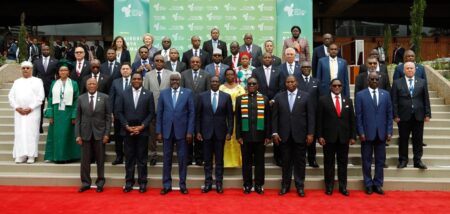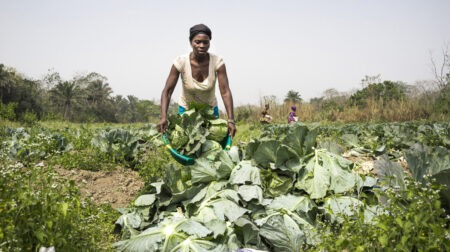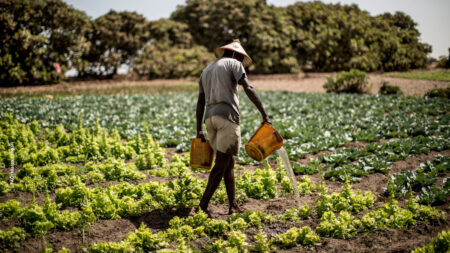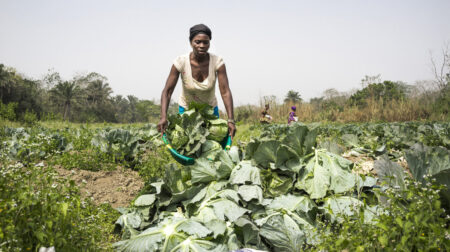Farmers in Tanzania can now access cheaper fertilizer for farm-production as Ministry of Agriculture reduces fertilizer costs.
In a press conference, on August 28th, the sector Minister Hon. Japhet Hasunga, highlighted the Tanzanian Bulk Procurement System (BPS) which he said operates on a competitive basis, said that the adjustment of the prices formula serves farmers’ interests.
Currently, fertilizer pricing will be based on a different formula, triggered by 12 percent decrease of Di-Ammonium Phosphate (DAP) fertilizer (a favorable input in maize production in Tanzania) to the source, the government also revised pricing formulas within farming year 2017/2018 and 2019/2020 respectively.
Across regions in Tanzania, 3.4 to $ 4 are the prices per 50 kg DAP-fertilizer bag, equivalent to 13 to 17 percent decrease. A 25kg fertilizer bag is now selling at $2.17 to $2.61 equal to 14 to 19 percent decrease respectively.
A 15 DAP fertilizer bag is now sold at $0.57 to $0.65 which is a 15 to 20 percent decrease respectively.
However, fertilizer prices, particularly to the DAP bags within eastern, northern and southern regions, will be sold at a directed price of $22.58 and $26.23.
The latter is purely a distinctive action towards affirming the 2006 Abuja Declaration on Fertilizer for the African Green Revolution, which calls not only for a 6 percent increase in agricultural production but also the increment in fertilizer application on farmland to increase from 8 kg per hectare to 50kg per hectare.
Agriculture in Tanzania, employment over 65.5 percent of the population who are providing for almost 100 percent of domestic food needs. Through the past decade agriculture has been experiencing various agrarian transformations, such as Kilimo Kwanza Program, in 2016; The Agricultural Sector Development Programme, Japan policy and Human Development and Southern Agricultural Growth Corridor of Tanzania.
The price reduction ultimately will prove millions of tons in production and billions in revenue, if operated seamlessly and with a strategic focus. This comes in the context that, Tanzania is marking its way into cereal production especially maize where, more than 5 million tons are produced, raising a bit above the national requirement, according to the 2018/2019 Food Security report.
READ: Will digital agriculture bring economic development to Africa?
Relief to Farmers
African Development Bank (AfDB) indicate almost US $ 4 billion is lost in soil nutrients year. On that note, Tanzania like in all developing nations, nearly 67 percent of the population live in rural areas of which most of them engage in agricultural activities, spending money in farmland inputs to support their lives, thus low fertilizer prices bring relief in the efforts.
High prices of fertilizers, unmistakably mar their collective efforts in enhancing cultivation and incomes, thus the latter is offering something rather vital to the sector contributing over 29 percent to the GDP.
Available data indicate, DAP, Calcium Ammonium Nitrate (CAN) and Nitrogen Phosphorus Potassium (NPK) to be reliable Tanzanian farmers input choices that contribute hugely to farm production, especially on cereal crops farming, ending up in most meals in Tanzania.
In that context, with auxiliary relief in other agriculture subsidies, Tanzanian farmers could perform better in the sector that generates more food stock above requirement, 16.4 million tonnes above 13.8 national requirement, according to Bank of Tanzania August report.
Trimming down fertilizer prices is an important step towards harmonizing collective agrarian efforts, discouraging low productivity despite technological and marketing drawbacks that face the sector.
Boost Agricultural Production
Tanzania’s National Bureau of Statistics (NBS) 2019 first-quarter highlights to account 6.3 percent in the economy, and for maize, millet, cassava, sorghum and paddy to be leading contributors.
About 44 million hectares of land is arable, 33 percent of it is cultivated. This means, more yield could be extracted from farmlands with proper fertilization inputs.
And yet, this dependable sector in Tanzania has grown at 5.3 percent rate, entailing furthermore to the industrialization ambitions of the nation. As the current regime focuses much on improving conditions for establishing an industrial economy that will consume agricultural raw materials, for domestic markets and exportation.
In that line, agricultural products are primarily materials depended for industrialization, thus affordable fertilizers will certainly promote decent increase in production, necessary for adjustments to higher demands required for such industries.
Agricultural development prospects could be met in Tanzania. This means via dissecting various efforts made the Tanzanian government increase value within the sector.
The latter means efforts such as opening up markets, promoting production to small scale farmers, facilitating value addition on yields and provision of financial assistance via state-owned apparatus, Tanzania Agricultural Development Bank (TADB) which has offering tailor-made sectorial-services, including pre and post-harvest loans accompanied by decent rates.










